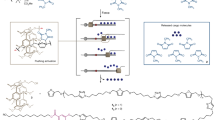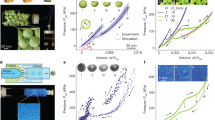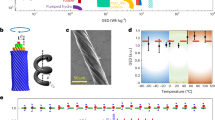Abstract
The development of three-dimensional (3D) synthetic biomaterials as structural and bioactive scaffolds is central to fields ranging from cellular biophysics to regenerative medicine. As of yet, these scaffolds cannot electrically probe the physicochemical and biological microenvironments throughout their 3D and macroporous interior, although this capability could have a marked impact in both electronics and biomaterials. Here, we address this challenge using macroporous, flexible and free-standing nanowire nanoelectronic scaffolds (nanoES), and their hybrids with synthetic or natural biomaterials. 3D macroporous nanoES mimic the structure of natural tissue scaffolds, and they were formed by self-organization of coplanar reticular networks with built-in strain and by manipulation of 2D mesh matrices. NanoES exhibited robust electronic properties and have been used alone or combined with other biomaterials as biocompatible extracellular scaffolds for 3D culture of neurons, cardiomyocytes and smooth muscle cells. Furthermore, we show the integrated sensory capability of the nanoES by real-time monitoring of the local electrical activity within 3D nanoES/cardiomyocyte constructs, the response of 3D-nanoES-based neural and cardiac tissue models to drugs, and distinct pH changes inside and outside tubular vascular smooth muscle constructs.
This is a preview of subscription content, access via your institution
Access options
Subscribe to this journal
Receive 12 print issues and online access
$259.00 per year
only $21.58 per issue
Buy this article
- Purchase on Springer Link
- Instant access to full article PDF
Prices may be subject to local taxes which are calculated during checkout






Similar content being viewed by others
References
Na, K. et al. Directing zeolite structures into hierarchically nanoporous architectures. Science 333, 328–332 (2011).
Schaedler, T. A. et al. Ultralight metallic microlattices. Science 334, 962–965 (2011).
Place, E. S., George, J. H., Williams, C. K. & Stevens, M. M. Synthetic polymer scaffolds for tissue engineering. Chem. Soc. Rev. 38, 1139–1151 (2009).
Wylie, R. G. et al. Spatially controlled simultaneous patterning of multiple growth factors in three-dimensional hydrogels. Nature Mater. 10, 799–806 (2011).
Kloxin, A. M., Kasko, A. M., Salinas, C. N. & Anseth, K. S. Photodegradable hydrogels for dynamic tuning of physical and chemical properties. Science 324, 59–63 (2009).
Dvir, T., Timko, B. P., Kohane, D. S. & Langer, R. Nanotechnological strategies for engineering complex tissues. Nature Nanotech. 6, 13–22 (2011).
Kraehenbuehl, T. P., Langer, R. & Ferreira, L. Three-dimensional biomaterials for the study of human pluripotent stem cells. Nature Methods 8, 731–736 (2011).
Hutmacher, D. W. Biomaterials offer cancer research the third dimension. Nature Mater. 9, 90–93 (2010).
Huh, D. et al. Reconstituting organ-level lung functions on a chip. Science 328, 1662–1668 (2010).
Baker, M. Tissue models: A living system on a chip. Nature 471, 661–665 (2011).
Schwille, P. Bottom-up synthetic biology: Engineering in a Tinkerer’s world. Science 333, 1252–1254 (2011).
Ruder, W. C., Lu, T. & Collins, J. J. Synthetic biology moving into the clinic. Science 333, 1248–1252 (2011).
Timko, B. P. et al. Electrical recording from hearts with flexible nanowire device arrays. Nano Lett. 9, 914–918 (2009).
Viventi, J. et al. A conformal, bio-interfaced class of silicon electronics for mapping cardiac electrophysiology. Sci. Transl. Med. 2, 24ra22 (2010).
Kim, D-H. et al. Materials for multifunctional balloon catheters with capabilities in cardiac electrophysiological mapping and ablation therapy. Nature Mater. 10, 316–323 (2011).
Viventi, J. et al. Flexible, foldable, actively multiplexed, high-density electrode array for mapping brain activity in vivo. Nature Neurosci. 14, 1599–1605 (2011).
Kim, D-H. et al. Epidermal electronics. Science 333, 838–843 (2011).
Tian, B. et al. Three-dimensional, flexible nanoscale field-effect transistors as localized bioprobes. Science 329, 831–834 (2010).
Qing, Q. et al. Nanowire transistor arrays for mapping neural circuits in acute brain slices. Proc. Natl Acad. Sci. USA 107, 1882–1887 (2010).
Cohen-Karni, T., Timko, B. P., Weiss, L. E. & Lieber, C. M. Flexible electrical recording from cells using nanowire transistor arrays. Proc. Natl Acad. Sci. USA 106, 7309–7313 (2009).
Timko, B. P., Cohen-Karni, T., Qing, Q., Tian, B. & Lieber, C. M. Design and implementation of functional nanoelectronic interfaces with biomolecules, cells, and tissue using nanowire device arrays. IEEE Trans. Nanotech. 9, 269–280 (2010).
Prohaska, O. J., Olcaytug, F., Pfundner, P. & Dragaun, H. Thin-film multiple electrode probes: Possibilities and limitations. IEEE Trans. Biomed Eng. 33, 223–229 (1986).
Nicolelis, M. A. L. (ed.) Methods for Neural Ensemble Recordings 2nd edn (CRC, 2008).
McKnight, T. E. et al. Resident neuroelectrochemical interfacing using carbon nanofibre arrays. J. Phys. Chem. B 110, 15317–15327 (2006).
Yu, Z. et al. Vertically aligned carbon nanofibre arrays record electrophysiological signals from hippocampal slices. Nano Lett. 7, 2188–2195 (2007).
Dequach, J. A., Yuan, S. H., Goldstein, L. S. & Christman, K. L. Decellularized porcine brain matrix for cell culture and tissue engineering scaffolds. Tissue Eng. A 17, 2583–2592 (2011).
Hanley, P. J., Young, A. A., LeGrice, I. J., Edgar, S. G. & Loiselle, D. S. Three dimensional configuration of perimysial collagen fibres in rat cardiac muscle at resting and extended sarcomere lengths. J. Physiol. 517, 831–837 (1999).
Engelmayr, G. C. Jr et al. Accordion-like honeycombs for tissue engineering of cardiac anisotropy. Nature Mater. 7, 1003–1010 (2008).
Lu, W. & Lieber, C. M. Nanoelectronics from the bottom up. Nature Mater. 6, 841–850 (2007).
Yan, H. et al. Programmable nanowire circuits for nanoprocessor. Nature 470, 240–244 (2011).
Wang, M. F., Maleki, T. & Ziaie, B. Enhanced three-dimensional folding of silicon microstructures via thermal shrinkage of a composite organic/inorganic bilayer. IEEE/ASME J. Microelectromech. Syst. 17, 882–889 (2008).
Sapir, Y., Kryukov, O. & Cohen, S. Integration of multiple cell-matrix interactions into alginate scaffolds for promoting cardiac tissue regeneration. Biomaterials 32, 1838–1847 (2011).
Xu, T. et al. Electrophysiological characterization of embryonic hippocampal neurons cultured in a 3D collagen hydrogel. Biomaterials 30, 4377–4383 (2009).
Cho, S. H. et al. Biocompatible SU-8-based microprobes for recording neural spike signals from regenerated peripheral nerve fibres. IEEE Sensors J. 8, 1830–1836 (2008).
Voskerician, G. et al. Biocompatibility and biofouling of MEMS drug delivery devices. Biomaterials 24, 1959–1967 (2003).
Zipes, D. P. & Jalife, J. Cardiac Electrophysiology: From Cell to Bedside 5th edn (Saunders, 2009).
L’Heureux, N., Pâquet, S., Labbé, R., Germain, L. & Auger, F. A. A completely biological tissue-engineered human blood vessel. FASEB J. 12, 47–56 (1998).
L’Heureux, N. et al. Human tissue-engineered blood vessels for adult arterial revascularization. Nature Med. 12, 361–365 (2006).
Neri, D. & Supuran, C. T. Interfering with pH regulation in tumours as a therapeutic strategy. Nature Rev. Drug Discov. 10, 767–777 (2011).
Kraut, J. A. & Madias, N. E. Metabolic acidosis: pathophysiology, diagnosis and management. Nature Rev. Nephrol. 6, 274–285 (2010).
Dvir, T. et al. Nanowired three-dimensional cardiac patches. Nature Nanotech. 6, 720–725 (2011).
Sekitani, T. et al. A rubberlike stretchable active matrix using elastic conductors. Science 321, 1468–1472 (2008).
Mannsfeld, S. C. B. et al. Highly sensitive flexible pressure sensors with micro-structured rubber as the dielectric layer. Nature Mater. 9, 859–864 (2010).
Takei, K. et al. Nanowire active matrix circuitry for low-voltage macro-scale artificial skin. Nature Mater. 9, 821–826 (2010).
Acknowledgements
We thank F. Kosar for help on μCT imaging of synthetic tissue samples and J. L. Huang for assistance with culture chamber preparation. C.M.L. acknowledges support from a NIH Director’s Pioneer Award and a McKnight Foundation Technological Innovations in Neurosciences Award. D.S.K. acknowledges a Biotechnology Research Endowment from the Department of Anesthesiology at Children’s Hospital Boston and NIH grant GM073626. R.S.L. acknowledges NIH grants DE013023 and DE016516.
Author information
Authors and Affiliations
Contributions
B.T., J.L., T.D., D.S.K. and C.M.L. designed the experiments. B.T. and J.L. performed experiments. T.D., J.T. and Q.Q. assisted in the initial stage of the project. L.J. and Z.S. performed calculations and simulations. B.T., J.L., D.S.K. and C.M.L. wrote the paper. All authors discussed the results and commented on the manuscript.
Corresponding authors
Ethics declarations
Competing interests
The authors declare no competing financial interests.
Supplementary information
Supplementary Information
Supplementary Information (PDF 2019 kb)
Rights and permissions
About this article
Cite this article
Tian, B., Liu, J., Dvir, T. et al. Macroporous nanowire nanoelectronic scaffolds for synthetic tissues. Nature Mater 11, 986–994 (2012). https://doi.org/10.1038/nmat3404
Received:
Accepted:
Published:
Issue Date:
DOI: https://doi.org/10.1038/nmat3404
This article is cited by
-
Graphene-integrated mesh electronics with converged multifunctionality for tracking multimodal excitation-contraction dynamics in cardiac microtissues
Nature Communications (2024)
-
Electro-metabolic coupling in multi-chambered vascularized human cardiac organoids
Nature Biomedical Engineering (2023)
-
Flexible brain–computer interfaces
Nature Electronics (2023)
-
Self-assembled ultraflexible probes for long-term neural recordings and neuromodulation
Nature Protocols (2023)
-
Laminin-coated electronic scaffolds with vascular topography for tracking and promoting the migration of brain cells after injury
Nature Biomedical Engineering (2023)



